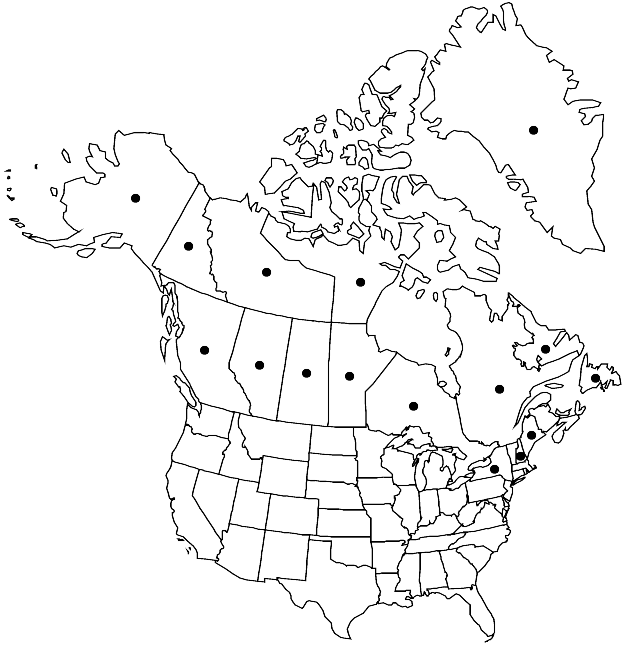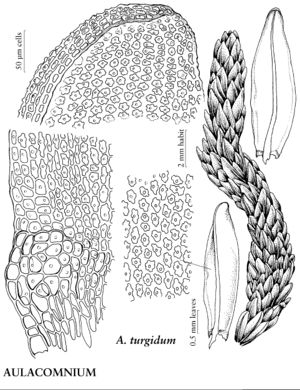Aulacomnium turgidum
Sp. Musc. Frond. Suppl. 3(1,1,Aulacomnion): 7. 1827.
Plants 3–8 cm, in dense erect cushions or prostrate mats, green, yellow-green, or fuscous green. Stems yellow; cross-section pentagonal, cortical cells in 2–5 irregular layers, medulla cell-walls thick to thin, central strand present; rhizoids usually covered by leaves except in older parts of plants. Leaves imbricate, not twisted when dry or moist, oblong to elliptic, widest above base, concave; base not rounded or narrowed to insertion; margins revolute 1–2 times to just before apex, entire; apex rounded-cucullate; costa flexuose toward apex; laminal cells round to oblong, papillae low; basal-cells usually 2-stratose, often brown. Specialized asexual reproduction absent. Perigonia as terminal discoid splash platforms; paraphyses of 6–9 cells. Perichaetia with paraphyses absent. Seta 0.2–0.3 cm. Capsule horizontal, 3–5 mm; operculum conic, rostrum short, blunt; endostome cilia nodose. Spores 8–13 µm, smooth.
Habitat: Arctic and alpine tundra meadows, heaths, fellfields, mineral soil, rock, near tree line under spruce, cirque headwalls, deep shaded canyons
Elevation: low to moderate elevations
Distribution

Greenland, Alta., B.C., Man., Nfld. and Labr., N.W.T., Nunavut, Ont., Que., Sask., Yukon, Alaska, Maine, N.H., N.Y., n Europe, Asia, Africa
Discussion
Aulacomnium turgidum often grows in pure mats or cushions and is distinctive in having broad cucullate leaf apices and closely imbricate leaves (hiding the rhizoids); the stems are julaceous and irregularly branched, the branching often associated with gametangial formation. Fossils of A. turgidum have been found at high elevations well south of its present range in eastern North America in sediments recording episodes of late Pleistocene tundra vegetation (N. G. Miller 1980). The alar regions on leaves of A. turgidum are sometimes excavate. The basal laminal cells of the inner perigonial leaves are irregular and smooth with walls evenly thickened. The outer perichaetial leaves are oblong; the inner leaves have serrulate margins at the apex and oblong to rhomboidal laminal cells with evenly thickened walls.
Selected References
None.
Lower Taxa
"widest" is not a number.
